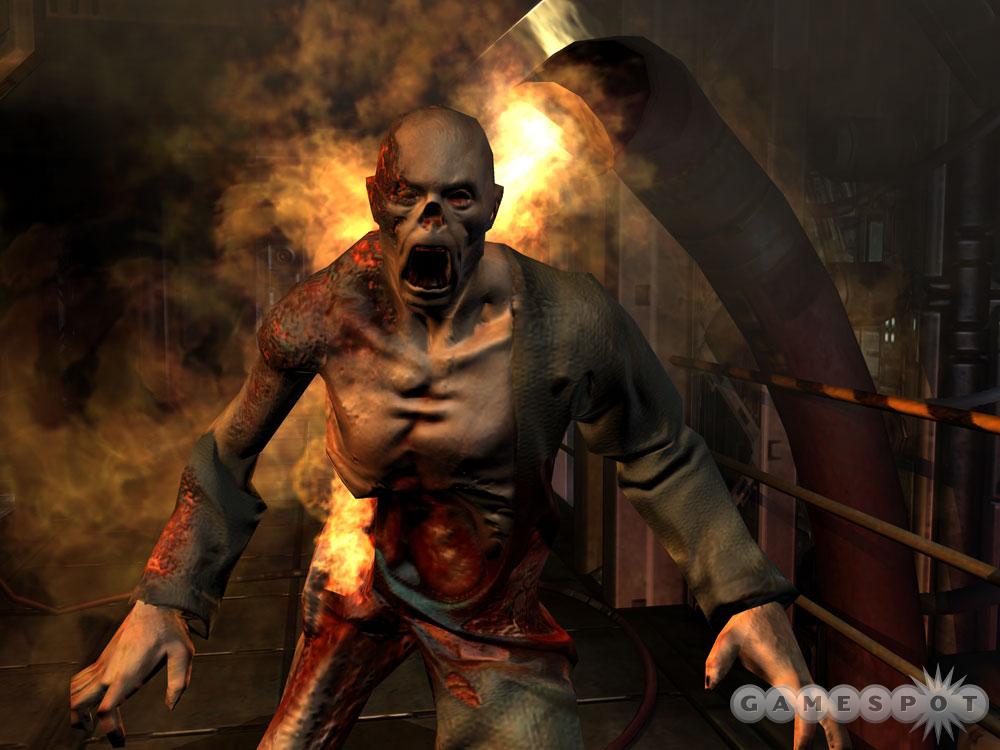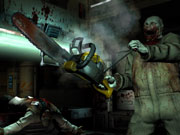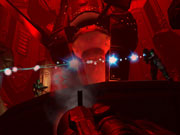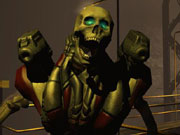Doom 3 Q&A - Todd Hollenshead and Tim Willits
After years in seclusion, the wizards of id emerge to talk about Doom 3, next-gen consoles, and soiled underwear.
For the last four-odd years, id Software has been in bunker mode. With the now-infamous phrase, "It will be ready when it's done," the staff of the studio that John Carmack built deflected all questions about the development of its groundbreaking PC shooter, Doom 3.

However, now that Doom 3 has gone gold, the wizards of id are hitting the publicity circuit, suddenly eager to chat about the title that will force thousands of gamers to shell out millions of dollars to buy PCs powerful enough to play it. In the midst of a recent media blitz, GameSpot got ahold of id CEO Todd Hollenshead and prime architect and lead designer Tim Willits to talk about Doom 3's long road to development, its next project, the future of gaming, and how to create a game scary enough to cause a person to soil his or her underwear.
DEVELOPMENT
GameSpot: To put it mildly, Doom 3 has been one of the most anticipated games of all time. When did you guys finally realize it was done?
Tim Willits: About 45 minutes before Todd announced it! [Laughs] No, actually, we were in beta testing with Activision for about two months or so. We'd wrapped the whole game, and we were just doing some multiplayer testing the last two weeks, making sure the game was as solid as it could possibly be. Literally, 45 minutes after we told Activision, it was a go. Todd made the announcement.
GS: Now the development cycle of this is pretty legendary, being upwards of four years...
TW: Well, when John announced Doom 3, he was working on Doom, but the rest of us weren't. But, yeah, it was a long development time. But we feel the game lived to the vision we had better than we even anticipated. It also proves that id will do whatever it can to make the game as great as possible.
GS: It seems a lot of other high-quality PC games are taking four or five years to develop. Do you think such long development cycles will have an adverse effect on the PC game market?
TW: Well, the development cycle for Doom 3 was at about four years from the very start of it. I count from the start until the finish. Some people start counting from the days where they start moving toward progress, but for me, the clock ticks from day one. The cycle has been a long time, compared with previous id products. Quake III only took a couple of years. Obviously, if development cycles continue to double, it's going to be problematic.
I can't really comment on what everybody else is doing. I can comment for id. We don't think the next game is going to take four years. Doom 3 technology is a brand-new paradigm in terms of the way the world reacts and is created, how art is created, how many textures have to be used, and how that stuff works. When you're working with technology that's not fully fleshed-out, the learning curve is very, very steep. Steep unlike any game that has ever been created. However, now that we've climbed that, we'll definitely benefit from having that experience for our next project.
RECEPTION
GS: How has the initial reception been among consumers? Can you reveal any preorder numbers?
Todd Hollenshead: I don't know the preorder stats. I know they were supposed to be very strong, but part of that was probably because of the preorder campaign that started last fall! [Laughs] It was a little earlier than our preference would have been for it to start, but we got pushed into that a little bit by Activision. Certainly the retailers have been very excited about it. I know the numbers for Activision are the biggest ever for any PC title they've done, and the ship will be bigger than for any id title before now. In the world of big, it's bigger than big. [Laughs]
GAME
GS: Word is Doom 3 will be as much--or more--about suspense than action. How did its development differ from a more standard shooter?
TH: I would say the game is more about terror than suspense, in terms of what it feels like when you play.
TW: Well, you know the development of Doom was much more different from that of any other game we've ever had to develop. We wanted to start out with a story so you have context for your action. We worked with a professional writer to help give us an area--a place for the gameplay. When it comes down to the suspense and the scare factor for Doom, it's all pacing. It's setting up the player with sound, with story, with lighting, with ammo, with monsters, and with hell. It's all carefully orchestrated. We manipulate the feeling of the player with all the assets and technology we have.
GS: We heard that the sound design is particularly groundbreaking.

TW: One of the great things about Doom 3 is that it has six channels of sound. If you have a system with six speakers, you can have creepy sounds behind you, monsters sneaking up on your sides. We moved away from songs that just looped to [instead] create a spooky soundscape within the game, and then we mixed that with pacing sounds.
TH: I'm a skeptic about almost everything, and I was sort of skeptical at first about the impact of the six-channel surround sound. But Tim came in and put speakers behind the computer I was testing on, and it really is an amazing difference in terms of how tense it feels when you're playing through the game. We had a bit of office antics where people would sneak into one another's offices to try to scare the s*** out of one another when we were playing the game. You're a lot more open when you've got speakers behind you because you can't hear people sneaking up behind you to grab you on the neck when you're about to get throttled by a hellknight [in the game]. That resulted in more than one or two changes of underpants in the office. [Laughs]
Skipping E3
DEMO
GS: How much later than the game do you expect the Doom 3 demo to be released?
TH: Well, we just finished the game, so we're all kind of recovering from shock. We're still trying to figure out what we want to do with the demo. Our goal is to make a piece of Doom 3 that gives players a feel for what Doom is. Doom is more than one level, so we have to be very careful to get the demo nailed down right. As soon as we figure out what we want to do and how we want to move forward, we can give more information on that.

MULTIPLAYER
GS: In regards to the multiplayer, why did you guys switch to a client-server model from the peer-to-peer architecture that you guys talked about at Quakecon 2002?
TW: There are a lot of things you do in Doom 3's multiplayer that are pretty cool. We have dynamic lights, we have physics objects. You can push barrels around and blow them up. We have many more entities. Just the nature of the dynamic world just creates much larger network traffic, and we found it was a lot more stable with a server-client model.
TH: It just worked better. There wasn't any one reason. It was just going be very hard to keep all the clients in sync with the peer-to-peer architecture, given all the different entity states that were being moved around. The level of sophistication in a given scene in Doom 3 versus Quake III is four or eight times as much. If any one element got out of sync, it would basically cause problems for the other clients, and that would be problematic for us to address. The original reason for peer-to-peer was that there were some lighting calculations that were problematic from a client-server standpoint but worked on peer-to-peer. So we traded one engineering hurdle for another one that we thought would work better. The client-server architecture is more expandable, especially when you start expanding the number of players to games. You don't start increasing exponentially the amount of network traffic that goes on. It was also viewed favorably by our [Doom 3 engine] licensees. They're used to configuring client-server and were concerned about introducing peer-to-peer to their network games.
GS: Will there eventually be a way for more than just four players to engage in a Doom 3 multiplayer game?
TH: That's just an artificial limit that we set. You are going to have to have a powerful server to have more than just four people playing on it. People's network connections are going to matter. Doom 3 is basically a broadband-only game. When you start adding clients, you're going to start adding traffic, and you're going to add latency and performance hits on the server. I have no doubt that one of the first mods for Doom 3 to come out will be eight-player Doom 3. But it's my guess that eight-player Doom 3 will be most effectively played on LAN servers.
GS: Will there be a dedicated server available at the game's release?
TH: The Win32 dedicated server is in the box. We should have the Linux-dedicated server out right about the time the game hits store shelves, if not concurrent with it.
HARDWARE
GS: In a recent magazine interview, one of your head programmers refused to recommend a current-generation, high-end rig for Doom 3, saying that it will look and play best with equipment that hasn't even been released yet. When can we expect to see the first hardware that will show the full potential of Doom 3's graphics?
TW: In a few days, we will announce a hardware analysis. We've done some tests and some examination, so you can expect to see more information on hardware in the next few days. [After this interview was conducted, id's John Carmack conducted a Doom 3 benchmark test with HardOCP.]
GS: Will Doom 3 be bundled with any specific graphics card packages, similar to the Half-Life 2/ATI Radeon deal?
TH: [Pauses] There's not anything about that that we can talk about.
XBOX DOOM 3
GS: Can you comment on the development of the Xbox version of Doom 3?
TH: Did you have a specific question about it?
GS: Well, we found it kind of curious that the Xbox version was playable at E3 and the PC version wasn't, but now the PC version's coming out, and there's no definite date for the Xbox version.
TH: Basically, we looked at that equation last fall. We asked ourselves, "Are we going to take [the PC] Doom 3 to E3 2004 or not?" Then we estimated the time frame when we wanted the game to be done. E3 can create nonproductive work for 90 days in the schedule for a game. We just didn't want to pull the entire dev team out to Los Angeles and basically have a week's worth of downtime. At that point, we knew that our task was not to be marketing the game but to be finishing the game. On the other hand, we knew that the Xbox version of Doom 3 has always been slated to be released behind the PC, notwithstanding the speculation that Microsoft paid us off. That has no basis at all. I will swear with my hand on a stack of bibles that there is no basis in reality for that speculation.

GS: OK.
TH: Anyway, we had not shown the Xbox version before, and there was a fair amount of skepticism about how good the Xbox version of Doom 3 was going to look. So we wanted to put that in people's hands and tell them, "Look, this version of the game looks kick-ass too." So as far as I'm concerned, it was "mission accomplished" at E3 this year.
GS: Todd, you were quoted in Chris Morris' CNN/Money column as saying that Doom 3 might not come out this year for the Xbox.
TH: I said I couldn't guarantee it, but I didn't rule it out.
The Future
NEXT PROJECT
GS: What is id's next project?
TW: It'll be a new IP, but, beyond that, we can't talk about it.

GS: Will its development be as long--or longer--than Doom 3's?
TW: We don't think the development cycle on our next project will be longer than Doom 3. In fact, we think it will be significantly shorter than Doom 3. However, in keeping with our philosophy about game development, we're not going to release it until it's done, regardless of how long it takes.
GS: I know Todd had mentioned in a recent television interview that a sequel to Return to Castle Wolfenstein is in the works. Can you guys comment on the progress of the development of that?
TH: Well, I probably said more than I should have in that interview, so I'll refrain from digging myself farther into a hole. [Laughs]
GS: What is the status of Quake IV right now?
TW: Raven is very, very busy working on Quake IV. They've done some amazing things with the technology and the gameplay. It is different enough from Doom 3 that people will be really excited about it. Id's very happy with it. As soon as we have more information to share with everybody, we will.
NEXT-GEN CONSOLES
GS: How has working with Vicarious Visions on the Xbox Doom 3 affected id's stance on console development? Will you also develop for next-generation consoles, or will you focus on PC games?
TH: We haven't gone through all that decision-making yet. But I think for our next project, we'll probably take a PC-centric approach, given what John Carmack said at his programming keynote at the Game Developers Conference this past spring. He said he didn't really like the technical aspects of the [next] generation of consoles--in terms of Xbox 2 and PlayStation 3--with their multithread approach, dual GPUs, and dual processors. They don't have the simple, elegant approach of a single CPU and a single GPU. Given that's where John thinks you can do the most exciting things from a technology standpoint, I expect that's where he's going to go from a programming standpoint.
GS: Does that mean you won't develop for next-gen consoles at all?
TH: We take the consoles very seriously. We put a lot of effort into Return to Castle Wolfenstein: Tides of War and Operation Resurrection. Return to Castle Wolfenstein did very well for us, and we're very serious about making Doom 3 for the Xbox the scariest console game you can buy. So as we go down the path toward our next development project, we'll look at the opportunities the consoles present to us.
GS: It's interesting what you said about Carmack because he was quoted several months ago as saying that he had "one good engine left in him." Now that Doom 3 engine is done, does id intend to get out of the technology-building business to focus more on games?

TH: First of all, I think that's a misquote. I think John's opinion is that he has at least one good engine left in him. And that's not even counting how he's going to augment the Doom 3 engine for id's next title. I've heard some speculation in the press about how long John's going to stay in the video game business. But John's approach to the video game business is no different from what it was five years ago or 10 years ago. He's going to continue to do it as long as he likes it. And as long as there are interesting technical challenges for him to solve, then I think he's going to continue to do it.
GS: What do you think those challenges will be?
TH: We're all realists about trying to crystal-ball stuff too far into the future. About as far as we're willing to look out is three to five years. Beyond that, people just can't predict what direction technology is going to take. I will challenge anyone to find someone who--beyond just happenstance or luck--predicted the technology path for today's video games 10 years ago. Anybody who purports to know what video games are going to be like in 10 years is full of crap. That's just the honest truth.
Got a news tip or want to contact us directly? Email news@gamespot.com
Join the conversation